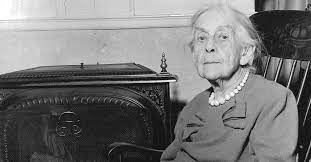Get the lead out! An innocent enough mandate when it is simply a call to get moving faster. But in Flint, Michigan, Washington, DC, Newark & Trenton, NJ, Chicago, IL, Baltimore, MD, Philadelphia & Pittsburg, PA, Milwaukee, WI, Boston, MA—get the lead out is a lifesaving remediation that is moving all too slowly to get the lead out, out of their pipes and water systems. Lead poisoning causes learning difficulties, irritability, fatigue, belly pain, constipations, loss of appetite, weight loss, vomiting, hearing loss, premature birth, miscarriage and developmental delays. All of this in the past 20 years. But lead poisoning is not a new issue. The dangers of lead poisoning were clearly and cogently documented in the early 1900s by Doctor Alice Hamilton.
Today I would like to give thanks to Doctor Hamilton for her pioneering, ground breaking and lifesaving work. Let me introduce you to a bit of her life and some of her accomplishments.
Alice Hamilton was born on February 27, 1869 in New York City. She grew up in Fort Wayne, Indiana. She studied medicine at the University of Michigan Medical School, taught medicine at the Woman’s Medical School of Northwestern University and Harvard Medical School. She lived at Jane Addams Hull House for over 35 years. And she died at 101 on September 22, 1970 in Hadlyme, CT.
Oh, but what she did with those 101 years! While she was at Hull House, she treated the local immigrants for diseases that were the consequence of their working conditions. In her autobiography, ‘Exploring the Dangerous Trades’, she said that life in a settlement teaches you that education and culture have little to do with real wisdom, the wisdom that comes from life experience. She personally thrived in the environment of Hull House, observing that “it satisfied every longing, for companionship, for the excitement of new experiences, for constant intellectual stimulation and for the sense of being caught up in a big movement which enlisted my enthusiastic loyalty. At Hull House, Alice Hamilton’s medical knowledge, linked with Jane Addams’ passion for social reform, and the lives for the working-class people, ignited her compassion and indignation. Alice Hamilton brought her education and cultural background to bear on the life experiences she gained at Hull House, and she changed our understanding of health and working conditions to enhance human dignity and public health.
In 1910, the governor of Illinois invited Dr. Hamilton to conduct a study of the extent of industrial sickness in the state. She became managing director of the survey of lead and enamelware industries, rubber production, painting trades and the explosive and munitions industries, with the study of the lead industries as her particular focus. Charles Neill, Commissioner of Labor in the U.S. Department of Commerce, later asked her to conduct a similar survey of all the United States. By the time Alice Hamilton was in her early 40s, she was the leading authority on lead poisoning and one of a very small group of experts in occupational diseases.
Alice Hamilton fully embraced her focus on industrial toxicology, which she described as “scientific in part, but human and practical in great measure.” In each of her investigations, she employed ‘shoe-leather’ epidemiology: careful and extensive analysis of hospital records to document the connection between specific illnesses and occupations, the thorough investigation of factories to learn which industrial processes used or produced dangerous chemicals. But she was not content to document the extent of lead poisoning. She personally tried to persuade factory owners and managers to remedy the dangerous conditions by instituting dust and fume prevention techniques; or by having workers wear protective clothing to be removed and washed at the end of each shift.
Alice Hamilton was a woman of her time and she was ahead of her time. Many of us owe our health and the good health of our relatives to her research and interventions. Thank You, Doctor Alice Hamilton.
{Alice Hamilton is one of nearly 90 women mentioned in my novel: Letters from Eleanor Roosevelt. You can find her there on page 92. Happy Reading!}

